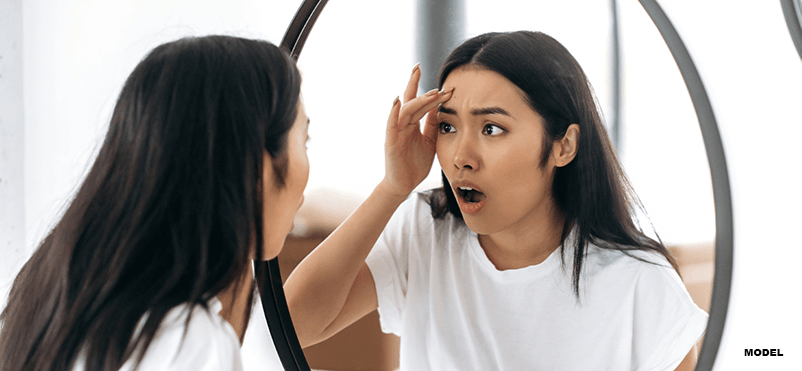Fungal Acne: Symptoms, Prevention, And Treatment Options

Not all blemishes are alike, and effective treatment plan for any skin issue requires a proper diagnosis. Fungal acne, also known as Malassezia folliculitis, is a skin condition that is often misdiagnosed as common acne. Standard acne treatments do little to help with the blemishes and bumps caused by fungal acne as their underlying cause is unique.
What is Fungal Acne?
Like the more common types of acne, fungal acne is a skin condition that is caused by a specific type of infection. Malassezia is a yeast-like fungus that occurs naturally in human skin. Under ideal conditions, your body manages the levels of the fungus without issue. Skin that is constantly damp, though, encourages the fungus to multiply. Over time, Malassezia invades your hair follicles and triggers an immune response, including inflammation and white blood cells. The battle to keep your skin healthy is apparent with the formation of small bumps on your skin that look like acne vulgaris.
How Does Fungal Acne Differ from Other Forms of Acne?
The key difference between fungal acne and acne vulgaris is the origin of the infection. Fungal acne is the result of a fungal infection whereas acne vulgaris is the result of a bacterial infection.
What Causes Fungal Acne?
Fungal acne requires a combination of circumstances to form on your skin. First, there must be an increase in the Malassezia fungus population on your skin. This may happen when your skin is persistently damp and hot, such as what happens during a long period of high humidity or when your skin is hot and sweaty. Second, the fungus infiltrates your hair follicles where it remains trapped. Your body responds to the fungus with an immune response that includes inflammation and white blood cells that cause swelling of the hair follicle and bumps on the surface of your skin.
Hair Follicle Damage and Fungal Acne
Damaging a hair follicle may increase the risk of fungal acne. Plucking, waxing, and shaving may increase the risk of Malassezia fungus getting trapped in your hair follicles. Other practices that may result in fungal acne include wearing tight clothing, rubbing skin against skin, and spending long periods in a jacuzzi. If you exercise on a regular basis, the combination of tight-fitting gym clothes and perspiration may increase the risk of fungal acne.
Antibiotics and Fungal Acne
Antibiotics work by reducing bacteria in your body, and this includes the good bacteria on your skin. The bacteria help regulate yeast levels on the skin. As the bacteria are eliminated, the levels of Malassezia fungus may increase significantly. Some medications and medical conditions also enable the fungus to grow uncontrollably which may increase the chances of having fungal acne.
What are the Signs of Fungal Acne?
Fungal acne has a similar appearance to acne vulgaris with some subtle differences. Small red bumps or whiteheads surrounded by red rings form in clusters, and each bump is approximately the same shape and size. The bumps may be filled with pus. Additionally, the skin may be tender, burning, and itchy. Fungal acne can be accompanied by other skin conditions, such as acne vulgaris, dandruff, and psoriasis.
Where Does Fungal Acne Occur on the Body?
Fungal acne most often forms on the back, arms, and chest. It may also occur on the shoulders, chin, forehead, upper arms, and neck.
Who is at Risk for Fungal Acne?
Fungal acne is most common among teenagers and young adults. You may be at higher risk if you have oily skin. Other risk factors include a weakened immune system, using oil-based skin care products, having hyperhidrosis, and living in a humid climate. Higher cases of fungal infection tend to occur in people who have other types of fungal infections, such as tinea versicolor and seborrheic dermatitis.
When Should I See a Dermatologist for Fungal Acne?
Seeing a dermatologist is an important part of managing fungal acne and preventing permanent skin damage. Schedule an appointment for evaluation. Schedule a follow-up appointment if the blemishes return after treatment.
Diagnosing Fungal Acne
A dermatologist can distinguish between acne vulgaris and fungal acne. The dermatologist reviews your symptoms and may recommend a skin scraping to look for signs of a fungal infection. During the appointment, be prepared to discuss your symptoms, as well as any treatments that you have tried to manage the blemishes.
Fungal Acne Treatment Options
Because Malassezia exists naturally on your skin, the goal of treatment is to restore healthy levels of the fungus. Your dermatologist may recommend an oral or topical anti-fungal medication. Research is showing some success with photodynamic light therapy, although this is reserved for more complex cases of fungal acne and for patients who experience side effects from medication.
How Long Does Fungal Acne Treatment Take?
Most patients will need to use the medications as prescribed by your dermatologist, even if your skin improves. On average, it takes up to one month to balance the flora on your skin and for most blemishes to be cleared away. Sometimes several months of treatment are necessary.
Can Fungal Acne Be Prevented?
The best way to prevent fungal acne is to keep your skin dry. Be sure to shower after exercising or when your skin feels damp from perspiration. Loose clothing helps, too, by promoting the natural evaporation of moisture on your skin. If you have dandruff, tinea versicolor, hyperhidrosis, seborrheic dermatitis, and other skin conditions that increase your risk of fungal acne, speak to a dermatologist about treatment options.
Disclaimer: The contents of the Westlake Dermatology website, including text, graphics, and images, are for informational purposes only and are not intended to substitute for direct medical advice from your physician or other qualified professional.
